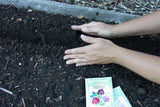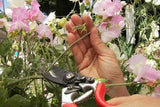
In mild winter climates, where the ground does not freeze, sweet pea seeds should be fall-sown directly into the garden from September through November to grow strong root systems and then bloom in spring. If you do not get your seeds planted in fall, plant as early as possible in the spring in a well drained spot that offers some afternoon shade.
In cold winter areas: wait until the harshest weather has past and sow about a month before the last frost date. If spring turns hot and humid early in your area, mulch seedlings well and plant where vines will get some afternoon shade.
1. You may choose to nick your sweet pea seeds before planting. Nicking the seed with a nail clipper breaks the outer coat of the seed so it can absorb water immediately. By doing this a larger percentage of your seeds will germinate and they will sprout a few days earlier.
Here's how: Hold a seed between your thumb and forefinger. With the other hand, hold the clippers at an angle so that you use one end of the blade, then clip your seed. Your goal is to make a slice through the brown top coat of the seed, not to take a chunk out. Sometimes you can barely see the nick you made and sometimes a piece of the seed coat cracks off and you see the lighter colored inner seed. Both are correct!
2. Sweet peas need well-drained, fertile soil, so before planting add some aged manure or other finished compost into your garden bed, work it into the soil, and rake the bed to create a fairly level surface. With a tool or stick, make a furrow. It is important to bury your seeds at the proper depth (1 in. for sweet peas) so make sure your furrow is 1 inch deep.
3. To sow your seeds, drop them into your furrow 2-3 inches apart. By sowing your sweet peas at this spacing, you are more likely to get a full bed of plants without gaps. Later, after your seeds have sprouted, you will thin them to their final spacing.
4. After sowing, cover your seeds by pulling soil over your furrow. Remember that you want your seeds to be 1 deep, so move just enough soil to fill in your trench without creating a mound over the seeds.
5. Gently water your covered seeds. Use a watering can or hose with an attachment that diffuses the water so that it sprinkles like a gentle rain – this will prevent the water from washing away the soil.
Tall sweet peas need a well-anchored support to climb up. Erect one now so that it will be in place as soon as your seedlings are ready to start climbing.
6. It is critical to protect your sweet pea seedlings from birds, snails and slugs. This should be done right after sowing your seed, otherwise these common predators may find your sprouts and eat them before you even know they are up!
For birds, use netting. We make our own support hoops from flexible, black plastic irrigation tubing, commonly called polytube, and available at most garden centers. Cut it in lengths appropriate for the width of your garden beds. Push the ends of the cut tubing into the soil to form arches over your sweet pea bed. Drape the bird netting over these arches and secure all edges, making sure there are no openings. Remove the netting before your sweet peas get tall enough to attach themselves to it.
For snails and slugs, we like the product Sluggo because it is non-toxic to humans, pets and wildlife.
7. If you started your seeds inside, you will need to harden off the seedlings before transplanting them into your garden. Hardening off means gradually acclimating your plants to the conditions they will encounter outside – direct sunlight and temperature being the most critical. If you do not do this, your seedlings may suffer transplant shock after you plant them into the garden.
Start the process of hardening off when your plants have about 3-4 pairs of leaves. Move your plants to a location outside that gets direct morning sun and afternoon shade. If you do not have such a location, each day you will need to move your plants into the sun in the morning and out of the sun in the afternoon. After about 3-4 days move them to a spot where they will get direct sun all day. In a few more days you can transplant them into your garden.
8. To keep your sweet pea plants blooming as long as possible, we recommend deadheading. This means cutting off spent flowers before they have a chance to divert energy towards making seeds instead of more flowers. The ideal time to deadhead is just after the bloom has peaked and is just beginning to fade. Always cut off the entire flower stem.
9. This plant has entirely finished blooming. As you can see, the spent flowers form seedpods and the plants slow down and then stop blooming altogether. Eventually, all sweet pea plants come to the end of their flowering life whether you deadhead or not, but you can prolong the bloom period by cutting off spent flowers.
10. Of course the whole point of growing sweet peas is the flowers. Don't forget to cut some and bring them into the house - they make beautiful, sweetly scented bouquets. And the more flowers you cut, the more the plant will produce!
11. All of the varieties at Renee's Garden are grown and evaluated in our test gardens. When we evaluate sweet peas we look at many factor: flower color, scent, and form; plant vigor and disease resistance; and seed quality.

Sweet Pea Heaven!
Renee evaluating new varieties in our Sweet Pea seed producer's growing field.











